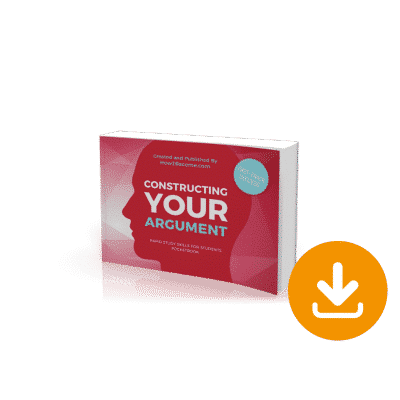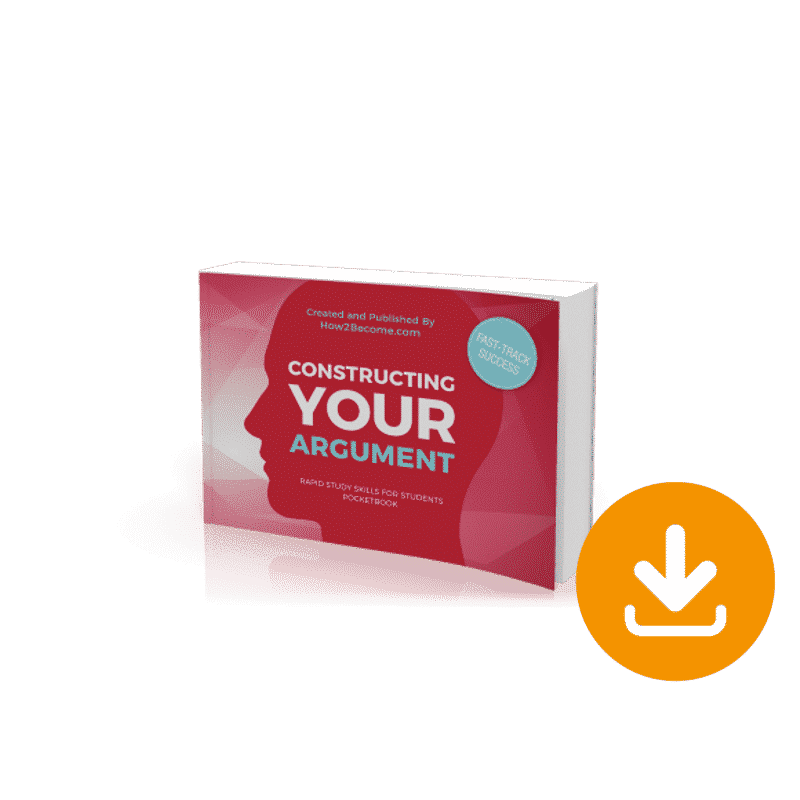CONSTRUCTING YOUR ARGUMENT
Constructing Your Argument: Rapid Skills For Students is the comprehensive guide to creating excellent critical arguments for written and verbal presentation. Whether you’re writing an essay, participating in a debate, or giving a slideshow presentation, strong argumentative skills are vital for helping your ideas shine. In this book, you’ll receive the essential tips and tricks for researching, planning, writing, and presenting your argument, giving you the best chance of achieving the best grades.
WHAT IS A CRITICAL ARGUMENT?
A critical argument is one in which two or more parties use evidence and reasoning to substantiate ideas and theories. Critical arguments are considered to be more high-brow than common spats and verbal fights you might have with someone when angry, and are the basis for a lot of philosophical, political, and even scientific discussion.
WHY SHOULD I CARE?
If you’re a student taking a course in any of the Humanities subjects (such as History, English Literature, Philosophy, Politics, or Economics), then being able to argue effectively is a necessity. You’ll have to learn the common pitfalls of constructing an argument, such as logical fallacies, then be prepared to identify them in an academic setting. In addition, you’ll need to be able to construct your own arguments, understand how to address counterarguments, and use evidence to effectively support your own ideas. In this book, you’ll have access to tips on all of these and more!


SAMPLE TIPS – ORGANISING YOUR RESEARCH
When it comes to organising your research, you should try to place everything useful you find into categories. Here are some examples of areas you should try to cover in your research:
- Background information on the issue – Data, terminology, and other pieces of information that don’t necessarily belong to a certain side of a debate. These will form a part of the ‘bedrock’ for your own argument.
- Arguments in favour of your own central thesis – These are ideas presented by other people that you can refer to in your argument. When including them, make sure that you reference them correctly so that you aren’t accused of plagiarism.
- Evidence for your own central thesis – Supporting evidence will hold up your own arguments, and therefore your central thesis, under scrutiny. Without strong evidence, most arguments will not be taken seriously.
- Other central theses in line with your own – These are central theses which have been devised by other writers and thinkers which, although they don’t necessarily say the same thing as you, both yours and their ideas are compatible.
- Other central theses which contradict your own – These are central theses which are not compatible with your own. In many cases, these will be arguments that you need to refute.
- Evidence for opposing central theses – This is the evidence for the perspectives which contradict your own argument. You might find yourself picking holes in this evidence to destabilise the opposing argument.
- Potential criticisms of your own central thesis – You need to keep on the lookout for existing criticisms of your own arguments. This means that you can address them in your argument, or prepare beforehand for them in a verbal debate.
SAMPLE TIPS – PLANNING YOUR ARGUMENT
Find Your Topic
The first step in writing an argument is to know what you’re actually going to be arguing over. Find out the following:
- What the topic is;
- What the main sides of the argument are;
- Why the topic is important;
- Some context to how the topic fits in with the bigger picture (e.g. how religious moral systems play into the larger subject of ethics).
Read All Sides of the Debate
Once you have a rough idea about the topic you’re going to be writing about or speaking on, you need to know all sides of the debate. Even though you’re ultimately going to pick one side, you need to ‘know your enemy’ in the sense that you need to understand their perspective. Take this time to read up on all sides of the debate thoroughly.
Note: Often, there’s more than two sides to any single debate. Try to find nuance in the major positions to see if there are alternatives that you could investigate.
Choose a Position
Depending on what your argument is being used for, you might not be able to choose your position. For example, if you’re taking part in a debating competition, you might be allocated a position on a specific topic. Other cases, such as certain essays, might demand you to take a specific side.
However, if you have the opportunity to choose your position, spend some time considering which argument you think you have more to say about. It also helps if you’re passionate about that side of the debate, but isn’t vital. Choose the position which you think will allow you to say something interesting.
Whatever the case, you must end up taking one side. Examiners won’t look kindly on someone who has tried to sit on the fence between two or more positions.
Brainstorm Some Arguments
Once you’ve chosen your position, it’s time to think of the main argument for it, or the main argument against the position that you’re attacking. You should try to think of one major line of argument, which should be made up of lots of small arguments or points. This main line of argument will be your central thesis: the main thing that you’re trying to say. We’ll discuss argumentative structure in more detail later in this chapter, but for now remember that each point of your argument should contribute to the overall conclusion.
Find Supporting Evidence
Once you have some ideas, it’s time to find evidence to either support them or disprove them. Go through each of your potential arguments and look for support evidence as well as counterarguments. If you think an argument is untenable due to too many flaws, then ditch it and focus on the rest. Over time, you should end up with the strongest arguments remaining.
Research and Think of Counterarguments
If you followed the previous point, you should already have some potential counterarguments for your strongest points. If not, you need to come up with some yourself. Thinking of counterarguments is important for the following reasons:
- If you think of the counterargument yourself, you have the time to address it properly. Sometimes, this might mean you can think of a strong response, but in other cases you may just have to concede.
- Acknowledging counterarguments, whether you’re able to defeat them or not, shows a level of sophistication and holistic reasoning in your argument.
- If you’re in a debate, knowing the possible criticisms of your position means that you’ll be ready to respond effectively, making you more confident in your argument.
Once you have all of the above areas researched and covered, you need to start thinking about how all of your ideas are going to fit together. This will be the focus of the next few sections.
FREE BONUS – ARGUMENT CONSTRUCTION FLOWCHART

Included in this guide is a downloadable Argument Construction Flowchart, complete with an example chart and tips for helping you to construct a killer argument for your next essay or presentation!

✓ 30-Day Money-back Guarantee
Did you know? All orders with How2Become are protected by our 30-day money-back guarantee. What ever the reason…or no reason at all…you can have your money back if this resource isn’t right for you (see our terms for full details).











